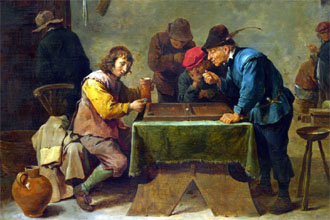|
| Magriel's NYT Columns |
 In backgammon, games that appear hopelessly lost can sometimes be dramatically turned around with proper play. Even when the opponent has almost completed his bearoff, it is often possible to hit a late shot and go on to win.
In backgammon, games that appear hopelessly lost can sometimes be dramatically turned around with proper play. Even when the opponent has almost completed his bearoff, it is often possible to hit a late shot and go on to win.
Choosing to wait for a last-minute shot, however, can often be costly. Failure means almost certainly losing by a gammon and possibly even a backgammon (or triple game). A backgammon, usually a rare event, occurs when the winner bears off all his checkers before his opponent bears off any, and does so while his opponent has one or more checkers in the winner’s home board.
The risk of being backgammoned must be seriously weighed when your opponent’s only remaining men are on the 23-point. In this case, a general rule may be stated: With a single man on the 24-point, it is correct to stay back when your opponent has five or more men on the 23-point; to run out of his home board when he has four or less. This rule has one important exception: When your opponent has exactly three men remaining on the 23-point, it is advantageous to stay back.
|
| Black to play 4-3. |
White can avoid leaving a shot only by rolling doubles (1 chance in 6). Of course, any double (except 1-1) will enable White to bear off his remaining three men and backgammon Black. The chances, however, are much greater (5 chances in 6) that White will not roll a double; with every other roll, White must leave at least one man exposed.
Notice particularly what happens when White’s roll includes a 1 (i.e., 6-1, 5-1, 4-1, 3-1, 2-1). After taking a man off, White is compelled to use his 1 to hit Black on the 24-point and so leave his two remaining men open. Black now has a double direct shot as he reenters from the bar. If Black hits either of White’s men, there is an excellent chance, with proper technique, that he will be able to hit the other man eventually. Should Black succeed in hitting both of White’s last two men, experience has shown that Black will be a clear favorite to win. Such a sequence of events, which is not so uncommon in actual play, has been dubbled the “coup classique.”
The correct play is 13/6. Black waits back on the 24-point hoping for the “coup” to materialize. Meanwhile, it is important that Black not close his 1-point. If White is forced to leave two exposed men, and Black hits one of them, Black wants to create the maximum opportunities of hitting the other. By leaving the 1-point open, he allows White to reenter and hit Black there. Being sent back gives Black additional shots at White’s other man, which must sit alone defenselessly.
Rollout
 Tom Keith 2013 |
|
Money play Black owns 2-cube Black rolls 4-3 1296 games with VR Checker play: 2-ply Cube play: 3-ply Red |
| 4-3: | Game | G | BG | Equity | ||||
| 1 | 13/9, 7/4 |
W L |
.0832 .9168 |
.0000 .6869 |
.0000 .1837 | −1.6693 |

| |
| 2 | 13/10, 7/3 |
W L |
.0832 .9168 |
.0000 .6878 |
.0000 .1841 | −1.6700 | (0.0007) | |
| 3 | 13/9, 6/3 |
W L |
.0824 .9176 |
.0000 .6876 |
.0000 .1849 | −1.6721 | (0.0028) | |
| 4 | 13/10, 6/2 |
W L |
.0813 .9187 |
.0000 .6866 |
.0000 .1844 | −1.6746 | (0.0053) | |
| 5 | 13/6 |
W L |
.0811 .9189 |
.0000 .6869 |
.0000 .1851 | −1.6765 | (0.0072) | |
| 10 | 24/17 |
W L |
.0000 1.000 |
.0000 1.000 |
.0000 .0000 | −2.0000 | (0.3307) |

|
|

